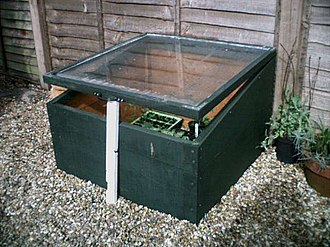| (20 intermediate revisions by 5 users not shown) | |||
| Line 1: | Line 1: | ||
| − | '''Hotbed''' | + | <noinclude><translate><!--T:1--> |
| + | </noinclude> | ||
| + | '''Hotbed''' | ||
| − | + | <!--T:2--> | |
| + | A hotbed is a pile of decaying organic matter warmer than its surroundings due to the heat given off by the metabolism of the microorganisms in the decomposing pile. Hotbeds are used for composting and keeping delicate plants warm during the winter. | ||
| − | + | <!--T:3--> | |
| + | '''Cold Frame''' | ||
| − | + | <!--T:4--> | |
| + | [[Image:Coldframe 1.jpg|thumb|''A traditional home made cold frame'']] | ||
| + | In agriculture and gardening, a '''cold frame''' is a transparent-roofed enclosure, built low to the ground, used to protect plants from cold weather. The transparent top admits sunlight and relies on the greenhouse effect to reflect back radiant heat that would otherwise escape at night. Essentially, a cold frame functions as a miniature greenhouse season extension device. | ||
| − | + | <!--T:5--> | |
| + | Cold frames are found in home gardens and in vegetable farming. They create microclimates that provide several degrees of air and soil temperature insulation, and shelter from wind. In cold-winter regions, these characteristics allow plants to be started earlier in the spring, and to survive longer into the fall and winter. They are most often used for growing seedlings that are later transplanted into open ground, and can also be a permanent home to cold-hardy vegetables grown for autumn and winter harvest. | ||
| − | + | <!--T:6--> | |
| − | + | Cold frame construction is a common home or farm building project, although kits and commercial systems are available. A traditional plan makes use of old glass windows: a wooden frame is built {{units|30-60 cm|1-2 feet}}, and the window placed on top. The roof is often sloped towards the winter sun to capture more light, and to improve runoff of water, and hinged for easy access. Clear plastic, rigid or sheeting, can be used in place of glass. An electric heating cable, available for this purpose, can be placed in the soil to provide additional heat. | |
| − | + | <noinclude></translate></noinclude> | |
| − | |||
| − | |||
Latest revision as of 14:06, 7 October 2021
Hotbed
A hotbed is a pile of decaying organic matter warmer than its surroundings due to the heat given off by the metabolism of the microorganisms in the decomposing pile. Hotbeds are used for composting and keeping delicate plants warm during the winter.
Cold Frame
In agriculture and gardening, a cold frame is a transparent-roofed enclosure, built low to the ground, used to protect plants from cold weather. The transparent top admits sunlight and relies on the greenhouse effect to reflect back radiant heat that would otherwise escape at night. Essentially, a cold frame functions as a miniature greenhouse season extension device.
Cold frames are found in home gardens and in vegetable farming. They create microclimates that provide several degrees of air and soil temperature insulation, and shelter from wind. In cold-winter regions, these characteristics allow plants to be started earlier in the spring, and to survive longer into the fall and winter. They are most often used for growing seedlings that are later transplanted into open ground, and can also be a permanent home to cold-hardy vegetables grown for autumn and winter harvest.
Cold frame construction is a common home or farm building project, although kits and commercial systems are available. A traditional plan makes use of old glass windows: a wooden frame is built 30-60 cm![]() , and the window placed on top. The roof is often sloped towards the winter sun to capture more light, and to improve runoff of water, and hinged for easy access. Clear plastic, rigid or sheeting, can be used in place of glass. An electric heating cable, available for this purpose, can be placed in the soil to provide additional heat.
, and the window placed on top. The roof is often sloped towards the winter sun to capture more light, and to improve runoff of water, and hinged for easy access. Clear plastic, rigid or sheeting, can be used in place of glass. An electric heating cable, available for this purpose, can be placed in the soil to provide additional heat.

